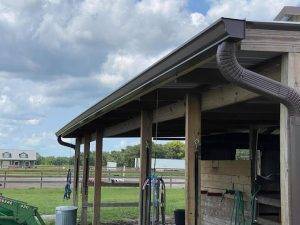Rain gutter installation is a crucial aspect of home maintenance that often goes unnoticed until problems arise. Properly installed gutters effectively manage rainwater, preventing damage to your home’s foundation, landscaping, and exterior. In this comprehensive guide, we’ll walk you through the essentials of rain gutter installation, from understanding the benefits to choosing the right materials and methods.
Benefits of Professional Rain Gutter Installation
Enhanced Water Management
Proper rain gutter installation ensures effective water management by directing rainwater away from your home’s foundation. This prevents water from pooling around the base of your house, which can lead to costly foundation damage and erosion. A well-designed gutter system captures and channels water efficiently, safeguarding your property from potential water-related issues.
Preventing Foundation Damage
One of the primary benefits of rain gutter installation is the prevention of foundation damage. When gutters are improperly installed or clogged, water can overflow and erode the soil around your foundation. This erosion can lead to cracks and settling in your foundation. By investing in a quality gutter system, you protect your home’s structural integrity and avoid expensive repairs.
Improving Curb Appeal
Rain gutters also play a role in enhancing your home’s curb appeal. Well-maintained gutters contribute to a clean, polished look, while improperly installed or damaged gutters can detract from your home’s appearance. Professional installation ensures that gutters are aligned and functional, adding to the overall aesthetic value of your property.
Types of Rain Gutters
K-Style Gutters
K-style gutters are a popular choice due to their sleek, modern appearance and high capacity for handling water flow. These gutters have a flat bottom and a decorative front, resembling crown molding. They are suitable for various architectural styles and are available in several materials, including aluminum and vinyl.
Half-Round Gutters
Half-round gutters are characterized by their semicircular shape and classic design. They offer effective water flow and are often used in traditional or historical home styles. While they might require more maintenance than K-style gutters due to their open shape, they provide a timeless aesthetic that complements many types of architecture.
Box Gutters
Box gutters are designed to be integrated into the roofline and are often used in commercial buildings or large homes. These gutters are concealed and have a rectangular cross-section, providing a sleek look while efficiently managing water flow. They require precise installation and regular maintenance to ensure proper function.
Choosing the Right Material for Your Gutters
Aluminum Gutters
Aluminum gutters are a popular choice due to their lightweight nature, durability, and resistance to rust. They are available in various colors and styles, making them a versatile option for many homes. Aluminum gutters are also relatively easy to install and maintain, providing long-lasting performance.
Copper Gutters
Copper gutters offer a distinctive, elegant look and are known for their durability and resistance to corrosion. Over time, copper develops a beautiful patina that adds character to your home. However, copper gutters are more expensive than other materials and require proper installation to maximize their lifespan.
Vinyl Gutters
Vinyl gutters are an affordable option that is lightweight and resistant to rust and corrosion. They are easy to install and come in various colors to match your home’s exterior. However, vinyl gutters may not be as durable as metal options and can become brittle in extreme temperatures.
Essential Tools and Equipment for Gutter Installation
Measuring Tools
Accurate measurements are crucial for successful rain gutter installation. Essential measuring tools include a tape measure and a level. Use these tools to ensure that your gutters are properly sized and aligned. Accurate measurements help prevent issues with water flow and ensure a proper fit for your gutters.
Cutting and Joining Tools
To cut and join gutter sections, you’ll need specific tools such as a hacksaw or a power miter saw for cutting, and gutter connectors or sealant for joining sections. Proper cutting and joining techniques are essential to avoid leaks and ensure that the gutters function as intended.
Safety Equipment
Safety is paramount during rain gutter installation. Use safety equipment such as ladders with stabilizers, gloves, and safety goggles to protect yourself from falls and injuries. Proper safety precautions help ensure a safe and successful installation process.
Steps for Installing Rain Gutters
Measuring and Planning
The first step in rain gutter installation is measuring and planning. Determine the length of the gutters needed and identify the locations for downspouts. Plan the layout to ensure proper water flow and avoid areas where gutters might overflow or become clogged. Accurate measurements and a well-thought-out plan are key to a successful installation.
Cutting and Fitting the Gutters
Once you have your measurements and plan, cut the gutter sections to size using appropriate tools. Fit the sections together and secure them in place using gutter brackets and fasteners. Ensure that the gutters are level and properly aligned to facilitate efficient water flow and prevent leaks.
Securing the Gutters in Place
After fitting the gutters, secure them in place with gutter hangers or brackets. Ensure that the hangers are spaced evenly and that the gutters are properly supported. Proper securing prevents sagging and ensures that the gutters remain functional over time.
Gutter Installation Tips and Best Practices
Ensuring Proper Slope
One of the critical aspects of rain gutter installation is ensuring proper slope. Gutters should have a slight slope towards the downspouts to facilitate water flow. A slope of approximately 1/4 inch for every 10 feet of gutter length is generally recommended. Proper slope prevents water from pooling in the gutters and reduces the risk of overflow.
Avoiding Common Installation Mistakes
Common mistakes in rain gutter installation include improper alignment, inadequate slope, and incorrect fastening. To avoid these issues, double-check measurements, ensure proper slope, and use the right tools and materials. Following best practices helps ensure that your gutters function effectively and last longer.
Sealing and Waterproofing Techniques
To prevent leaks, use gutter sealant at joints and corners. Apply the sealant evenly and allow it to dry according to the manufacturer’s instructions. Proper sealing and waterproofing techniques are essential for preventing water damage and ensuring that your gutters perform as intended.
How to Maintain and Clean Installed Gutters
Regular Cleaning Routines
Regular cleaning is essential for maintaining your rain gutters and preventing clogs. Remove leaves, twigs, and debris from the gutters and downspouts at least twice a year. In areas with heavy foliage, more frequent cleaning may be necessary. Regular cleaning ensures that water flows freely through the gutters and prevents overflow.
Inspecting for Damage
Periodically inspect your gutters for signs of damage, such as cracks, rust, or sagging. Address any issues promptly to prevent further damage and ensure the gutters remain functional. Regular inspections help catch problems early and extend the lifespan of your gutter system.
Repairing Common Issues
Common gutter issues include leaks, clogs, and sagging. Use a gutter sealant to repair leaks, clear out debris to address clogs, and adjust hangers to fix sagging. Proper repairs and maintenance help keep your gutters in good condition and ensure they continue to protect your home effectively.
Hiring a Professional for Gutter Installation
Benefits of Professional Installation
Hiring a professional for rain gutter installation offers several benefits, including expertise, efficiency, and access to high-quality materials. Professionals have the skills and experience to ensure a proper installation, reducing the risk of errors and ensuring that your gutters function effectively.
What to Look for in a Gutter Installer
When hiring a gutter installer, look for experience, positive reviews, and proper licensing and insurance. A reputable installer will provide a detailed estimate and warranty for their work. Ensuring that the installer meets these criteria helps guarantee a successful and reliable installation.
Cost Considerations
The cost of professional gutter installation varies based on factors such as the type of gutters, materials used, and the complexity of the installation. Obtain quotes from multiple contractors and compare the costs, taking into account the quality of materials and workmanship. Budgeting for professional installation ensures that you get a good value for your investment.
DIY vs. Professional Installation
Advantages of DIY Installation
DIY rain gutter installation offers the advantage of cost savings and the satisfaction of completing the project yourself. It allows you to choose your materials and work at your own pace. For those with the necessary skills and tools, DIY installation can be a viable option.
Risks and Challenges of DIY
DIY installation comes with risks and challenges, including the potential for errors, safety hazards, and a lack of warranty. Without professional experience, you may encounter issues with alignment, slope, and sealing. Assess your skills and comfort level before deciding to undertake a DIY project.
When to Opt for Professional Help
Consider professional help for rain gutter installation if you lack experience, tools, or time. Professionals can handle complex installations and ensure that your gutters are installed correctly. Opting for professional help minimizes the risk of errors and ensures a high-quality installation.
Addressing Common Gutter Problems
Clogged Gutters
Clogged gutters are a common issue that can lead to overflow and water damage. Regular cleaning and maintenance help prevent clogs. If you notice water overflowing or pooling, check for debris and clear it out promptly.
Leaking Joints
Leaking joints can occur at gutter seams and corners. Use gutter sealant to address leaks and ensure that joints are properly sealed. Regular inspections help identify and address leaks before they cause significant damage.
Sagging Gutters
Sagging gutters can result from improper installation or excessive debris. Adjust hangers and supports to correct sagging, and remove any debris that may be causing additional weight. Proper alignment and support help maintain the functionality of your gutters.
Innovations in Rain Gutter Systems
Rain Chains and Their Benefits
Rain chains offer an attractive alternative to traditional downspouts. They allow water to flow down decorative chains, creating a visually appealing and calming effect. Rain chains also help manage water flow and reduce the risk of splashback.
Gutter Guards and Protection Systems
Gutter guards and protection systems help prevent debris from entering the gutters, reducing the need for frequent cleaning. These systems come in various styles, including mesh and foam, and can significantly improve gutter performance and longevity.
Smart Gutter Technology
Smart gutter technology includes sensors and monitoring systems that alert you to potential issues, such as clogs or overflow. These advanced systems provide real-time data and help you address problems before they become serious.
FAQs
1. What is rain gutter installation?
Rain gutter installation involves setting up a system of gutters and downspouts to collect and direct rainwater away from your home’s foundation.
2. How often should I clean my gutters?
Gutters should be cleaned at least twice a year, or more frequently if you have overhanging trees or heavy debris.
3. Can I install rain gutters myself?
Yes, you can install rain gutters yourself if you have the necessary tools and skills. However, professional installation ensures proper alignment and reduces the risk of errors.
4. What are the benefits of hiring a professional for gutter installation?
Hiring a professional ensures expert installation, access to high-quality materials, and a warranty for their work. It also reduces the risk of errors and safety hazards.
5. What materials are best for rain gutters?
Common materials for rain gutters include aluminum, copper, and vinyl. Each material has its own advantages in terms of durability, cost, and appearance.
6. How do I prevent my gutters from clogging?
Install gutter guards or screens to prevent debris from entering the gutters. Regular cleaning and maintenance also help prevent clogs.
7. What should I do if my gutters are leaking?
Use a gutter sealant to repair leaks at joints and seams. If leaks persist, check for proper alignment and consider professional repair.
8. How do I know if my gutters are properly installed?
Check for proper alignment, slope, and secure attachment. Ensure that water flows smoothly towards the downspouts without pooling or overflowing.
9. What are gutter guards and do I need them?
Gutter guards are devices that cover gutters to prevent debris from entering. They can reduce the frequency of cleaning and improve gutter performance.
10. How can I address sagging gutters?
Adjust the hangers and supports to correct sagging. Remove any debris causing additional weight and ensure that gutters are properly aligned and supported.
Conclusion
Recap of Key Points
Rain gutter installation is essential for maintaining the integrity of your home and preventing water damage. By understanding the benefits, types, materials, and installation techniques, you can make informed decisions about your gutter system. Regular maintenance and timely repairs further ensure the effectiveness of your gutters.
Final Tips for Effective Gutter Installation
For effective gutter installation, focus on proper measurements, alignment, and sealing. Consider professional help if needed, and invest in quality materials for long-lasting performance. Regular maintenance and inspections help keep your gutters in optimal condition.
Encouragement to Take Action
Maintaining a well-installed and functional rain gutter system is crucial for protecting your home from water damage. Use the information provided to assess your gutter needs and ensure that your installation and maintenance practices are up to standard. Taking proactive measures will safeguard your property and enhance its value.
Related Posts

How to Choose the Best Gutter Materials for Long-Term Durability

Seamless Gutter Benefits for Modern and Historic Homes Alike

Keeping Your Gutters in Shape All Year with Seasonal Maintenance

How Professional Gutter Installation Prevents Basement Flooding

5 Most Common Causes of Gutter Damage in Residential Homes


